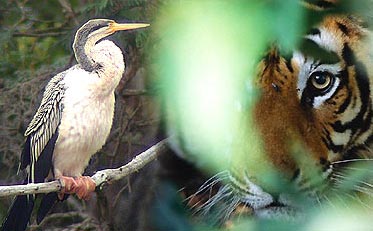 |
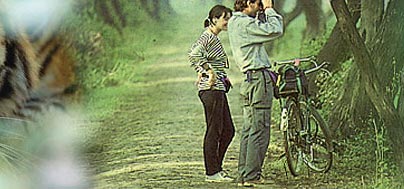 |
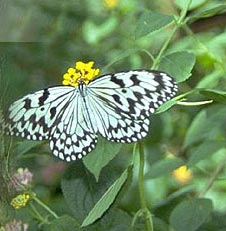 |
||
|
||||
Wild Expeditions India
-------------------------------------------------------------------------------------------------------------------------------------------------------------------------------------------------
Wild Expeditions India
Corbett National Park ¤ Historical Background ¤ Habitat ¤ Map of Corbett National Park
Mammals Checklist ¤ Reptiles Checklist ¤ Birds Checklist ¤ Wildlife Information
Wildlife Watching ¤ Conservation ¤ Tours with Corbett
-------------------------------------------------------------------------------------------------------------------------------------------------------------------------------------------------
Wild Expeditions India
Corbett National Park ¤ Historical Background ¤ Habitat ¤ Map of Corbett National Park
Mammals Checklist ¤ Reptiles Checklist ¤ Birds Checklist ¤ Wildlife Information
Wildlife Watching ¤ Conservation ¤ Tours with Corbett
-------------------------------------------------------------------------------------------------------------------------------------------------------------------------------------------------
Habitat
The Ramganga valley once supported an ancient, relatively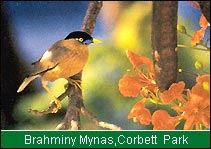 unstudied
civilisation. Vestiges of their existence can be seen in the form of terra cotta
remains and temple ruins that lie along the river. The community seems to have
been a farming one that had worked hard at clearing parts of the jungle for
agriculture. But theirs seemed to be a losing battle against a forest that would
cyclically reclaim its lands. Sal Shorea robusta forests once grew all the way
from Punjab to Assam. But humans encroached the jungles, and by the time Jim
Corbett arrived on the scene, most of these forests had already been cleared.
Nevertheless, this was still a favourite shikar area and many animal trophies
that decorated the walls of British soldiers and officers in North India came
from these parts. Timber to feed the insatiable demands of the British government
also came from here and it was only when Major Ramsay, a British officer with
vision and sensitivity, called a halt to the destruction that the combined havoc
of cultivation, grazing and timberfelling came to an end.
unstudied
civilisation. Vestiges of their existence can be seen in the form of terra cotta
remains and temple ruins that lie along the river. The community seems to have
been a farming one that had worked hard at clearing parts of the jungle for
agriculture. But theirs seemed to be a losing battle against a forest that would
cyclically reclaim its lands. Sal Shorea robusta forests once grew all the way
from Punjab to Assam. But humans encroached the jungles, and by the time Jim
Corbett arrived on the scene, most of these forests had already been cleared.
Nevertheless, this was still a favourite shikar area and many animal trophies
that decorated the walls of British soldiers and officers in North India came
from these parts. Timber to feed the insatiable demands of the British government
also came from here and it was only when Major Ramsay, a British officer with
vision and sensitivity, called a halt to the destruction that the combined havoc
of cultivation, grazing and timberfelling came to an end.Years later, E.A. Smythies of the Imperial Forest Service tentatively proposed the declaration of the area as a National Park, and in 1936, it was finally notified as the Hailey National Park, named after Governor Hailey of the United Provinces. After India gained her Independence from the British, the name was changed to Ramganga National Park in 1952. In 1957, officers and locals who knew just what a major role Jim Corbett had played in protecting the forest, marking its boundaries and championing the protection of the animals of the Ramganga, asked for it to be renamed after the legendary hunter-conservationist. Many of Jim Corbett's enthralling tales, including the Maneaters of Kumaon and the Maneating Leopard of Rudraprayag originated in these famous Kumaon hills, where the shikari used to hunt wild animals, until F. W. Champion, who pioneered wildlife photography in India, taught him to appreciate living tigers.
Eventually Gentleman Jim put his guns down in favour of the camera; and that is the example that all humans who venture into this magnificent Park must now emulate. The forest was re-christened the Corbett National Park in 1957. By the 1970s it was apparent that the tiger was in trouble and that less than 2,000 animals survived in the wild. Project Tiger was thus set up in April 1973 to protect the tiger and its habitat. Appropriately, the Corbett Tiger Reserve was the location for the launch of Project Tiger.
Forests
Predominantly sa/. The following forest types are found within the reserve.Northern Moist Deciduous Forests - Moist Shiwalik sa/, moist bhabar dun sa/, western Gangetic moist mixed deciduous, alluvial savannah woodland.
Northern Tropical Dry Deciduous Forests - Dry Shiwalik sa/, northern dry mixed deciduous, khair sissoo.
Himalayan Subtropical Pine Forests - Lower Shiwalik chir pine.
Grasslands
Locally known as chaurs. It is estimated that about
one-tenths of the total area of the reserve is under grass cover. The largest grassland is the Dhikala Chaur. Some of the best areas under grasslands, including the famous Buxar Chaur and the Beri Chaur, were submerged by the Ramganga reservoir in 1974. The area made available as a result of the relocation of the Dhara, Jhirna and Kothirau Chaurs in 1994 is being developed into grasslands through habitat alteration.
Wetlands
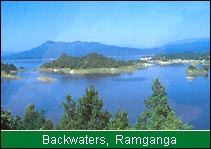
The Ramganga reservoir, which came into being in 1974, stretches over an area of around 82 sq. km., with one half each in Corbett National Park and Sonanadi Wildlife Sanctuary. The highest water level is reached at the end of the monsoon. Water is released when necessary from the multipurpose hydroelectric dam at Kalagarh for irrigation and the reservoir shrinks in spread, ultimately being reduced to a mere 40 sq. km. at the end of the summer. The bare areas temporarily develop into grasslands.
Riverine Areas
The Ramganga river is the lifeline of the Corbett Tiger Reserve, its principal tributaries being the Mandai, Palain and Sonanadi. Numerous mountainous streams locally called sots flow into these rivers. The nul/ahs and ravines are thickly covered with evergreen shrubs and glades, which provide undisturbed cover for the tiger and ready drinking water. A part of the catchment of the Kosi river falls within the reserve. There are no other major rivers.
Water Bodies
Mailani Tal and Phul Tal located in the Bijrani Range are stagnant water bodies.
Swamps
Many areas located along the boundary of the Ramganga reservoir and along springs are swampy, typically covered withjamun trees and cane, providing good cover for the
tiger to rest in during the hot summer months.
| Home | About Us | FAQ's | Contact Us | Commendations | Reservation |
| Copyright © Wildlife India Plus ( All Rights Reserved. ) | Web Development & SEO Services by |

